The Adaptive Moving Average (AMA) modifies the amount of smoothing it applies to data in an attempt to adjust to the changing needs of a dynamic market. It makes these adjustments based on the readings from a Volatility Index (VI). Any measure of volatility or trend strength can be used, however in this article we will focus on how the AMA performs using an Efficiency Ratio (ER). This is the VI that Perry Kaufman used when he presented the AMA in his book Smarter Trading (1995).
The ER-AMA requires four user selected inputs: An Efficiency Ratio Period, a High – Low smoothing period range for the AMA and a power that Alpha is raised to. We tested trades going Long, using Daily data, taking End Of Day (EOD) and End of Week (EOW) signals~ analyzing combinations of:
ER = 10, 20, 40, 80, 126, 252
Alpha Power (P) = 0.5, 0.75, 1, 1.5, 2, 2.5
AMA Actual Fast Moving Average (FN) = 1, 4, 10, 20, 40, 60
AMA Actual Slow Moving Average (SN) = 100, 150, 200, 250, 300
The ER lengths were selected due to the fact that they correspond with the approximate number of trading days in standard calendar periods: 10 days = 2 weeks, 20 days = 1 month, 40 days = 2 months, 80 days = ⅓ year, 126 days = ½ year and there are 252 trading days in an average year.
The AMA ranges were selected because they should capture the best results based on what we know from previous research into moving averages. Each time the Alpha Power was adjusted the SC and FC had to be modified to account for the change but the actual FN and SN stayed the same.
For instance a SC – FC range of 1 – 24 with alpha ^ 2 has an actual FN – SN range of 1 – 300 due to the effect of squaring alpha. Here is a table that shows the SC – FC ranges used so that the FN – SN ranges stayed constant regardless of ‘P’:
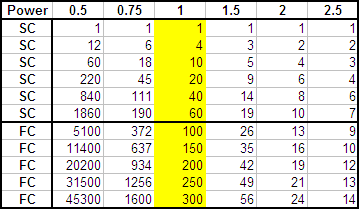
If that doesn’t make a lot of sense then please read our explanation of the Adaptive Moving Average. A total of 1020 different averages were tested and each one was run through 300 years of data across 16 different global indexes (details here).
Download A FREE Spreadsheet With Raw Data For
ER Adaptive Moving Average – Modifying Alpha by Raising to a Power
Kaufman had a theory that by squaring Alpha and thus causing the AMA to slow rapidly when the data lacked a strong trend he would achieve better results. Here we will put this theory to the test and be looking at the affect of raising Alpha to different powers:
Efficiency Ratio – AMA, Alpha to the Power of 1 – Annualized Return
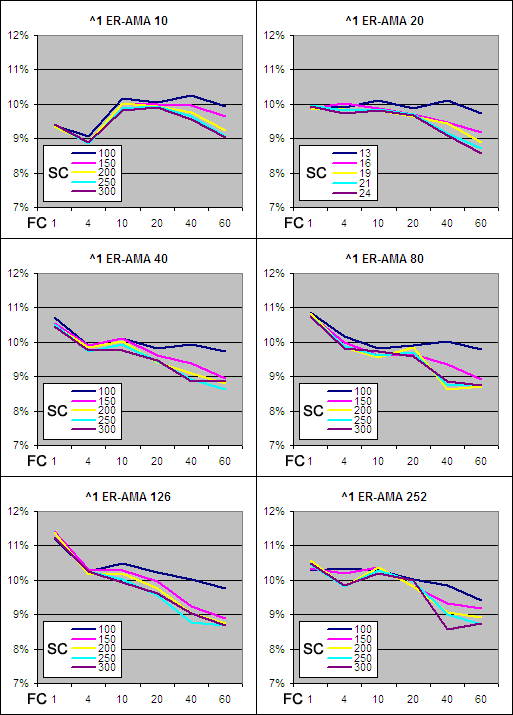
With Alpha ^1 there is no modification to alpha at all and the results are impressive. It can be said that in most cases as the FC increased the returns declined while changing the SC did not have much of an impact. ER lengths of 80 and 126 yielded the best returns, this finding is similar to that of our previous tests on other ‘intelligent’ moving averages.
Efficiency Ratio – AMA to the Power of 2 – Annualized Return
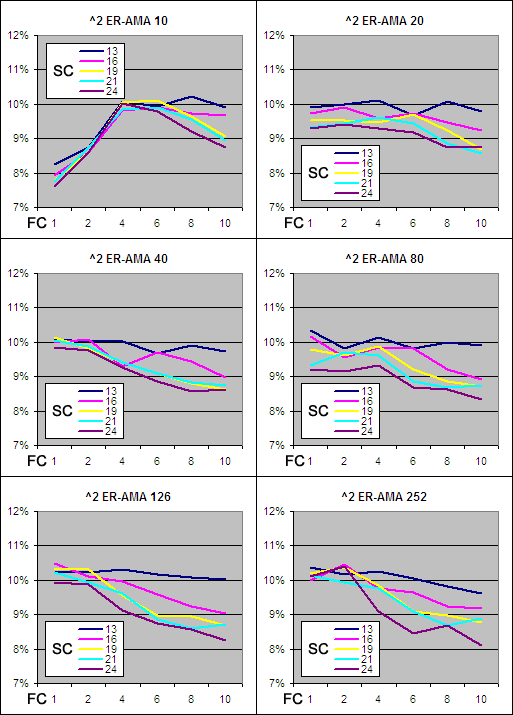
By raising Alpha to the power of 2 the returns drop almost across the board which immediately brings into question the need to include this function in the AMA formula and what would happen if we used a power below 1? It would appear as though the ER length needs to be at least 40 to be of value in this context with the best results again coming from ER lengths of 80 and 126. Clearly the FC is best when kept short so lets rework the charts to focus on what we now know works best:
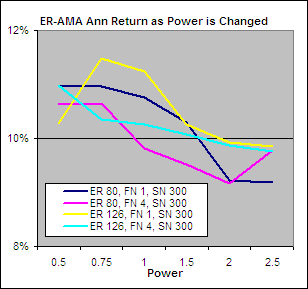
Now we are only looking at ER periods of 80 and 126 with a FN of 1 and 4 and a SN of 300. Each data point plots the change in returns with Alpha raised to different powers. As you can see, the best returns resulted from an ER period of 126 with alpha raised to the power of 0.75. As the Power was increased beyond this point, the returns decreased almost across the board. Therefore when using an Efficiency Ratio in an Adaptive Moving average you definitely should not square alpha as suggested in the original formula..
Best EOD Efficiency Ratio Adaptive Moving Average
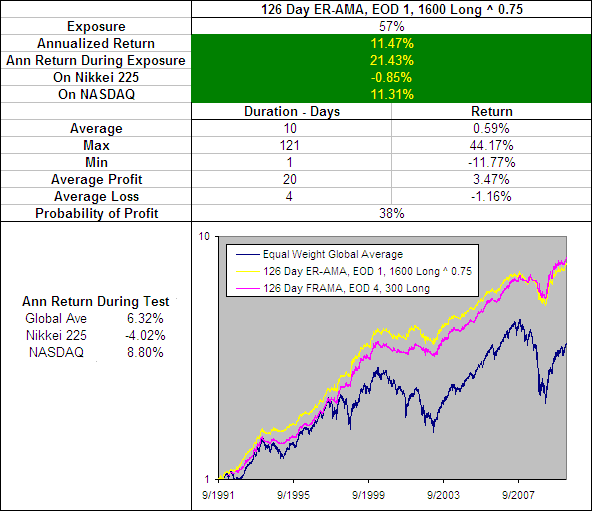
We have included on the above chart the performance of the 126 Day FRAMA, EOD 4, 300 Long becuase so far this has been the best performing Moving Average. The 126 Day ER-AMA, EOD 1, 1600 Long ^ 0.75 actually outperformed the best FRAMA up until 2008 when the market had a big pull back. As a result, over the full term of the test the FRAMA did perform slightly better. Also the FRAMA has a few added benefits such as turning a profit on the bear ravaged Nikkei 225 and having a 40% longer average trade duration (14 vs 10 Days).
On the Short side, the the ER-AMA also underperformed over the full term but again outperformed until 2008. This makes it very difficult to pick which moving average is the better of the two. But because our personal preference leans towards a longer trade duration we will stick with the FRAMA as being the best moving average we have found so far. (See the results on the short side)
126 Day ER-AMA, EOD 1, 1600 ^ 0.75 – Smoothing Period Distribution

Looking at the smoothing distribution you can see the 126 Day ER-AMA, EOD 1, 1600 ^ 0.75 is quite similar to that of the 126 Day FRAMA, EOD 4, 300 but the FRAMA spends more time as a slow average which explains the longer trade duration.
126 Day ER-AMA, 1, 1600 ^ 0.75 – Alpha Comparison
To get an idea of the readings that created these results we charted a section of the alpha for the 126 Day ER-AMA, 1, 1600 ^ 0.75 and compared it to the best performing FRAMA and the best ER-VMA to see if there were any similarities that would reveal what makes a good volatility index:.
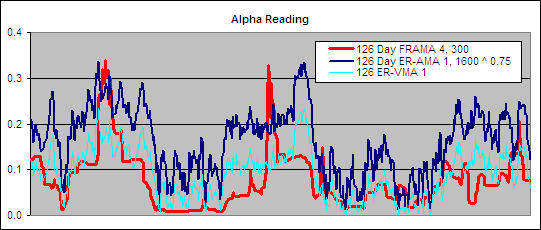
Because the ER-AMA and the ER-VMA both use the same volatility index, obviously their Alpha is identical apart from the slight modifications caused by the separate method of manipulating alpha. Remember, the higher the Alpha the faster the resulting average so you can see why the best ER-AMA was faster moving than the best ER-VMA. The Alpha patterns of the best FRAMA and best ER-AMA do have strong similarities but notice how the FRAMA is far less volatile. It is always preferable to work with indicators that generate clean readings with low levels of noise assuming they still produce good results.
Best EOW Efficiency Ratio Adaptive Moving Average
There are times when an average with a longer trade duration better suits ones needs so we also ran the tests looking for the best average using EOW signals:

We have included on the above chart the performance of the 252 Day FRAMA, EOW 40, 250 Long becuase so far this has been the best performing EOW Moving Average. The 252 Day ER-AMA, EOW 10, 100 Long ^1 underperforms by a fraction in most measures and while almost identical to the FRAMA it certainly is not superior. Performance on the short side tells the same story.
252 Day ER-AMA, EOW 10, 100 ^ 1 – Smoothing Period Distribution
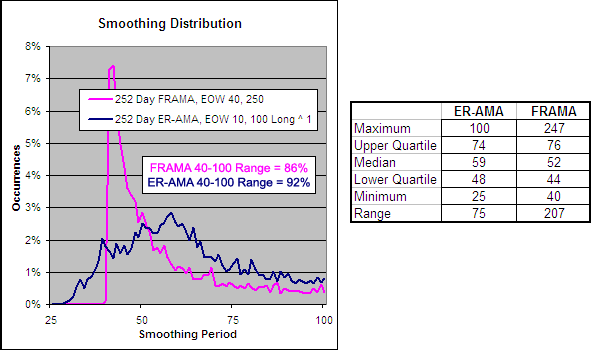
Looking at the smoothing distribution for the 252 Day ER-AMA 10, 100 ^ 1 you can see that it is far faster than the 252 Day FRAMA 40, 250 and has a more limited range despite the median, upper and lower quartiles being almost identical.
252 Day ER-AMA 10, 100 ^ 1 – Alpha Comparison
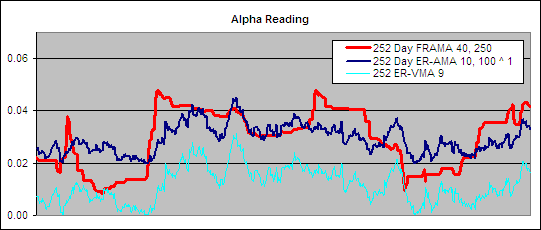 We have included on this chart the best EOW FRAMA and EOW ER-VMA. The ER-VMA and ER-AMA use the same volatility index but the 252 Day ER-AMA 10, 100 ^1 results in a higher Alpha which explains the faster average. The Alpha for the FRAMA and the AMA does stay in a similar zone but the FRAMA is far less volatile which is preferable.
We have included on this chart the best EOW FRAMA and EOW ER-VMA. The ER-VMA and ER-AMA use the same volatility index but the 252 Day ER-AMA 10, 100 ^1 results in a higher Alpha which explains the faster average. The Alpha for the FRAMA and the AMA does stay in a similar zone but the FRAMA is far less volatile which is preferable.
Conclusion
In the standard formula for the AMA, alpha is squared to force the average to slow rapidly during times when there is a lack of trend. When using an Efficiency Ratio as the Volatility Index (which is most commonly used VI in an AMA) we have clearly shown that squaring Alpha has a detrimental effect on returns. We suggest instead not modifying alpha at all or raising it to the power of 0.75
Overall the ER produced some impressive returns during out tests as the VI in an AMA as it did when we used in a VMA. The best performing EOD ER-AMA was a 126 Day ER-AMA, EOD 1, 1600 Long ^ 0.75 which did show periods of out performance over our current best performing MA the 126 Day FRAMA, EOD 4, 300 Long. However due to a longer trade duration we still rate the FRAMA as superior.
When it comes to an EOW or ‘slower’ moving average the 252 Day ER-AMA, EOW 10, 100 ^ 1 is almost identical to our current best ‘slow’ MA the 252 Day FRAMA, EOW 40, 250 Long but certainly does not offer any benefits.
Both the Efficiency Ratio and the Adaptive Moving Average have proven themselves against some formidable competition but based on our findings so far the FRAMA still remains slightly superior.
Want to use this indicator? Get a free Excel spreadsheet at the flowing link under Downloads – Technical Indicators: Adaptive Moving Average (AMA). It will automatically adjust to your choice of many different VIs including the Efficiency Ratio used in this article.
For more in this series see – Technical Indicator Fight for Supremacy
- ~ An entry signal to go long (or exit signal to cover a short) for each average tested was generated with a close above that average and an exit signal (or entry signal to go short) was generated on each close below that moving average. No interest was earned while in cash and no allowance has been made for transaction costs or slippage. Trades were tested using End Of Day (EOD) and End Of Week (EOW) signals on Daily data. Eg. Daily data with an EOW signal would require the Week to finish above a Daily Moving Average to open a long or close a short while Daily data with EOD signals would require the Daily price to close above a Daily Moving Average to open a long or close a short and vice versa.
- We used the average annualized return of the 16 markets during the testing period. The data used for these tests is included in the results spreadsheet and more details about our methodology can be found here.